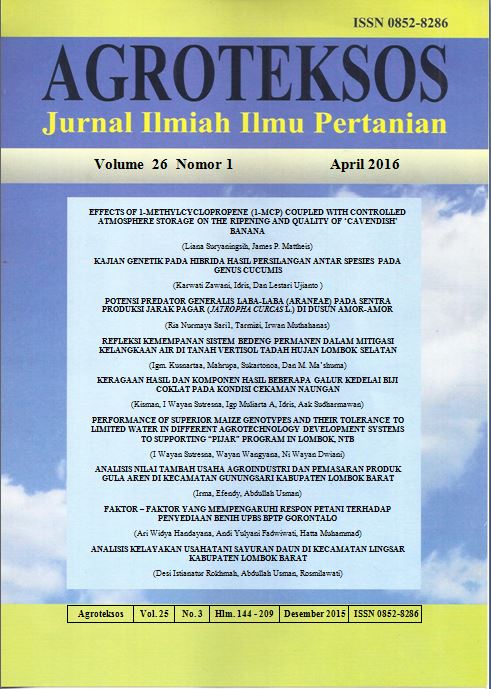KARAKTERISTIK PERTUMBUHAN DAN DAYA HASIL BEBERAPA JAGUNG VARIETAS HIBRIDA YANG DITANAM DENGAN POPULASI BERBEDA DI LAHAN KERING GROWTH CHARACTERISTIC AND YIELD POTENTIAL OF SOME MAIZE HYBRID VARIETIES GROWN AT DIFFERENT POPULATION DENSITIES ON A DRYLAND
Main Article Content
Abstract
Abstrak
Salah satu cara untuk meningkatkan hasil tanaman jagung adalah dengan meningkatkan kemampuan intersepsi cahaya matahari, khususnya pada akhir fase vegetatif. Empat varietas jagung hibrida, Bisi 816 (PT. BISI International Tbk.), NK 22 (Syngenta), P21 (Pioneer Hi-Bred International Inc.) dan Pertiwi 2 (PT. Agrimakmur Pertiwi), ditanam pada tiga populasi yang berbeda, 71.428, 83.333, dan 100.000 tanaman/ha di lahan kering Lombok Utara. Percobaandirancang dengan Split-plot tiga ulangan, yang mana populasi tanaman ditempatkan sebagai petak utama dan varietas sebagai anak petak. Tanaman dipupuk dengan Urea 500 kg/ha (150 kg/ha saat tanam, 200 kg/hapada umur 35 HST, dan 150 kg/ha pada umur 56 HST) dan pupuk NPK Phonska (15-15-15) sebanyak 380 kg/ha (sebagian pada saat tanam dan sisanya pada umur 35 HST). Hasil penelitian menunjukkan bahwa varietas Pertiwi 2 memiliki tinggi tanaman dan sudut daun terbesar, masing-masing 216 cm dan 33,6o, sementara tinggi tanaman lainnya <210 cm dengan sudut daun <30o. Tidak ada perbedaan dalam hal intersepsi cahaya matahari dari keempat varietas yang diuji, namun intersepsi cahaya meningkat dengan meningkatnya populasi. Intersepsi cahaya pada populasi terendah pada akhir fase vegetatif adalah 76% dan pada populasi tertinggi adalah 91%. Hasil dari varietas NK 22 dan P 21 setara dengan 7 ton/ha dan hasil pada populasi tertinggi setara dengan 7,4 ton/ha dibandingkan dengan hasil pada populasi terendah setara dengan 5,4 ton/ha. Varietas jagunghibrida dengan sudut daun yang sempit dapat ditingkatkan populasi tanamnya untuk meningkatkan intersepsi cahaya matahari guna meningkatkan hasil di lahan kering.
Abstract
One of the ways to improve yield of maize is by improving its ability in intercepting sunlight, especially at the end of vegetative state. Four maize hybrid varieties, Bisi 816 (PT. BISI International Tbk.), NK 22 (Syngenta), P21 (Pioneer Hi-Bred International Inc.) and Pertiwi 2 (PT. Agrimakmur Pertiwi), were grown at three different populations, 71,428, 83,333, and 100,000 plants/ha on a dryland of North Lombok. Treatments were arranged in a Split-plot Design with three replications, where population density was assigned as main plot and variety as sub-plot. Plants were fertilized with 500 kg/ha Urea (150 kg/ha at planting, 200 kg/ha at 35 DAP, and 150 kg/ha at 56 DAP) and NPK (15-15-15) Phonska of 380 kg/ha (half at planting and the rest at 35 DAP). At the end of the vegetative stage, Pertiwi 2 was measured as the tallest and had the widest leaf angle, 216 cm and 33.6o, respectively while others varieties had <210 cm in height and <30o in leaf angle. No difference in light interception among the four varieties but light interception increased with the increase of population density. Light interception at the lowest and highest population density was 76% and 91%, respectively. Yields of NK 22 and P 21 were equal to 7.0 ton/ha, and the yield at the highest and the lowest population density was equal to 7.4 and 5.4 ton/ha, respectively. Population density of maize hybrid varieties with narrow leaf angle grown on a dryland can be improved in order to increase their ability to intercept sunlight that lead to a higher yield.

